Yarrow, a delicate flowering herb with many uses and known by many names. This herb, steeped deeply in magical roots, may very well be the most versatile herb we grow.
This post may contain affiliate links at no additional cost to you. By making your purchases through the links on this website, IMSL may make a small percentage at no direct cost to you. IMSL only promotes products we use & truly believe in. Please refer to my Privacy & Disclosures for further information. IMSL thanks you for your support!
Yarrow or milfoil, whose common name is Achillia millefolium (translates literally to “thousand leaved”), is an herb which bears many names. Over 50 names to be exact. Even more colorful and rich than its name(s) is its use throughout history. European, Native American, and Chinese Medicine are known to have used this herb in many applications.
Also known as Herbe Militaire, or Military Herb due to its ability to staunch bloodflow and aid in healing, yarrow’s backyard medicinal uses reach so much farther than treating injuries that cut to the bone.
YARROW & ITS MANY NAMES
According to rxlist, yarrows many names include (but may not be limited to)….
Achilee, Achillea, Achillea borealis, Achillea lanulosa, Achillea magna, Achillea millefolium, Achillée, Achillée Boréale, Achillée Laineuse, Achillée Millefeuille, Acuilee, Band Man’s Plaything, Bauchweh, Birangasifa, Birangasipha, Biranjasipha, Bloodwort, Carpenter’s Weed, Civan Percemi, Common Yarrow, Devil’s Nettle, Devil’s Plaything, Erba Da Cartentieri, Erba Da Falegname, Gandana, Gemeine Schafgarbe, Green Arrow, Herbe à la Coupure, Herbe à Dindes, Herbe aux Charpentiers, Herbe Militaire, Huile Essentielle d’Achillée, Katzenkrat, Milefolio, Milenrama, Milfoil Millefeuille, Millefolium, Millefolii Flos, Millefolii Herba, Millegoglie, Noble Yarrow, Nosebleed, Old Man’s Pepper, Rajmari, Roga Mari, Sanguinary, Soldier’s Wound Wort, Sourcil de Vénus, Staunchweed, Tausendaugbram, Thousand-Leaf, Wound Wort, Yarrow Essential Oil.
RXList
Yarrows power, however, does not lay in its many name(s). Rather it rests in its history, folklore, & many benefits.
YARROW’S FOLKLORE & MAGICAL HISTORY
Yarrow has been linked to human activity for millennia. Thanks to modern archaeological practices, “fossils of yarrow pollen have been identified in Nanderthal burial caves” dating some 60,000 years ago according to a study by G P Shipley, et al, in 2016.
Regardless of the accuracy of that statement, we can firmly agree, yarrow is an old herb. Its Latin name, “Achillea”, comes from the Greek warrior, Achilles. Achilles is said to have used this herb to treat & heal war wounds, and this practice extended through the American Civil War.
Used in Chinese medicine to treat bleeding and inflammation, Native Americans (for treatment in at lease 28 ailments & lovingly considered a “life medicine”) for injuries & sores, and the Shakers for hemorrhages & flatulence, yarrow was an important ingredient in any home apothocary.
Yarrows roots also extend into the world of magics & myth. Cultures throughout the world refer to Yarrow as “the witches” herb. Long known for its protective & healing properties, history shows yarrow to be mentioned in many incantations & spells, escpecially where love is concerned.
Folklore has yarrow bundles hung over cradles to protect babies, as a charm resting on the right side of a pregnant woman to promote easy labor, strewn across thresholds & entry ways to keep unwanted spirits from entering, & hung over the bridal bed to create lasting love for seven years.
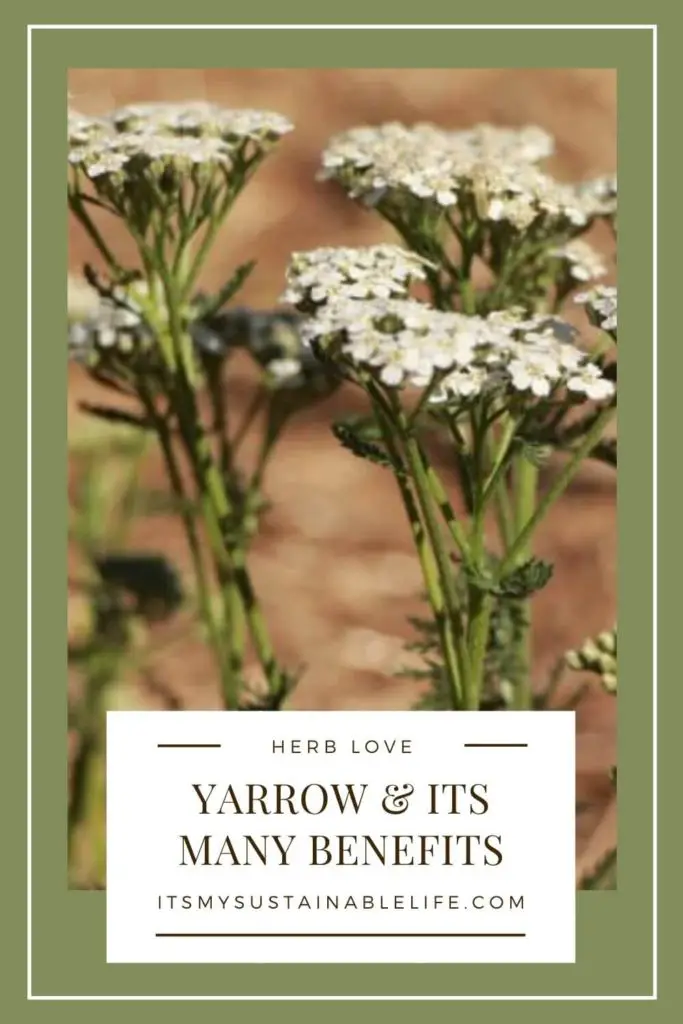
YARROW BENEFITS
Today yarrow can be easily considered our first aid plant. Treating everything from minor nosebleeds to “bruises to the bone” (falls, strains, pains, ligament issues, shin splints, & bone spurs), yarrow can come to the rescue. And studies are proving this.
Success was found in a 2-week study on healing episiotomy sites (surgical incision sites on a woman’s vaginal wall after giving birth) with a combination ointment treatment of this herb and St Johnswort.

Another study at the University of Vienna, showed that yarrows antispasmodic properties aid in the relief of Irritable Bowel Syndrome (IBS).
Yarrow is widely used for a plethora of applications.
- STOP BLEEDING – Stops bleeding when applied directly to the wound. To staunch bleeding, simply tear off a few leaves and apply directly to the wound. For more serious wounds, make a poultice or slurry by crushing and mixing the plant material with water and apply or use powder & apply
- AID CIRCULATORY SYSTEMS – Works as a circulatory tonic & aids in blood circulation when taken internally, helping to reduce blood pressure and may aid in the treatment of thrombosis
- COLD & FLU TREATMENT – Feeling under the weather? Have a dry fever? Brew up a cup of yarrow tea or take yarrow tincture internally. Drinking the tea hot will promote sweating and help to reduce & break a fever, and ease sore throats, & coughs
- TOOTHACHES – The analgesic properties help reduce tooth pain simply by chewing on a yarrow leaf or making a tooth”plug” for the affected area
- DIGESTIVE ISSUES – Flavonoids & alkoloids present in this bitter herb help to relieve digestive problems (think IBS, diarrhrea, bloating, & constipation)
- FEMALE ISSUES – Austrian herbalist, Maria Treben, referred to yarrow as “an herb for women” as its known to assist with vaginal discharge & painful menstruation
CONTRAINDICATIONS FOR USING YARROW
As with any medicinal herb used there are a few cautions to be taken into account. When trying any herb for the first time go slowly. Take a small amount, wait a day to observe any adverse reactions that may arise such as the ones below.
As yarrow is known to stimulate uterine contractions, it’s best to avoid yarrow products when pregnant.
Prolonged use externally can cause allergic reactions in some as well as cause some to develop sun sensitivities.
Large doses of yarrow can cause headaches in some.
Should you be taking any prescribed or over-the-counter medications, consult with your practitioner prior to taking yarrow as there my be adverse reactions.
We are not medical practitioners whatsoever. However, we do enjoy sharing information that has worked for us. We here at IMSL encourage self-education & always consult a medical professional prior to beginning any new regimen.
IDENTIFYING YARROW
Yarrow, an herbacious perrenial herb, is a member of the aster family. This herb grows via rizomes and reaches several feet in maturity. Yarrow can easily be confused with wild carrot and Queen Anne’s Lace.
There are over 140 specis in the Achillea family, but its the white version which can be easily foraged & grown that we will be focusing on. It’s unclear if hybrids contain the medicinal properties we are searching for.
This erect perennial herb boasts beautiful, lovely fernlike foliage which is covered with “hairs” creating a wooly like silky texture. Its leaves or foliage, reaching up to 6 inches long and 1 inch wide, are divided into many tiny leaflets, creating a feathery look.
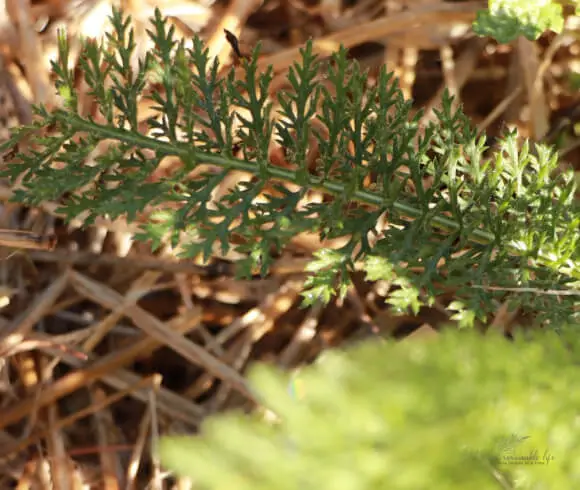
The flowers grow in a disklike fashion, resembling miniature daisies. Native to Europe, yarrow typically flowers from June through September, and can easily be foraged. Yarrow can be located in fields, lawns, and roadsides.
CULTIVATING YARROW
Should you choose to grow your own, yarrow is hardy to zone 2, enjoys a soil pH of 6.1, loves full sun and moderately rich, well-drained soil. Unless deadheaded, yarrow will readily spread, tho not invasively. Looking for a ground cover?
Yarrow will hold soil on steep banks and can be mowed yearly, forming deep, soft, green-mats.
It’s claimed that yarrow grown seaside or in mountainous regions contain the strongest medicinal qualities.
Few pests or problems affect this herb, but it may, under certain conditions, develop powdery mildew, rust, and stem rot. We have never had any issue with growing yarrow here on the hill.
Yarrows growth habit makes for wonderful companion planting, many claiming that the essential oils of other herbs being grown are increased when planted near yarrow. We have not noticed this, but who knows? It sounds lovely 🙂
FORAGING WILD YARROW
This distinctive herb is easily recognizeable, and readily available to forage. As with any herb or plant you are foraging, we encourage you to refrain from gathering roadside as chemicals & pollutants are abound, and the yarrow can accumulate particulates from vehicle exhaust.
Instead, look to open fields, lawns, and open spaces that are in full sun areas. Those in more urban spaces can look to unsprayed parks & open garden areas to forage. As with any plant, identify & confirm that what you are harvesting is indeed yarrow.
Forage yarrow during the height of the growing season, best at summer’s solstice, but July/August continue to offer blooms.
Always practice sustainable foraging practices. Taking just enough for your needs and leaving enough to thrive and re-grow.
Saving yarrows seeds from flowerheads that are dry is a wonderful way to begin growing your own source of this beneficial herb.
BENEFITS OF GROWING YARROW IN THE GARDEN
The benefits of growing your own, whether in your garden space or in pots, is ease! Ease of locating and harvesting. After all, it’s right in your own backyard!
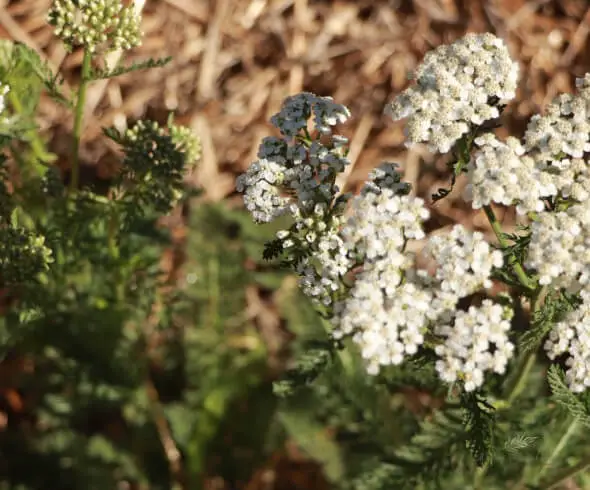
In addition, growing your own ensures you have a “clean” source of yarrow for your harvest! You know what’s been added or not, and that your harvest is as organic as possible.
According to a fellow gardening enthusiast, there are many more reasons to grow your own. The following points are taken from her article, “5 Reasons To Grow Yarrow”.
- Yarrow may accumulate nutrients in the soil. According to this source, yarrows “deep roots mine the subsoil for potassium, calcium, and magnesium.” Further, ” yarrow may also mine for phosphorus and copper, making it a potentially nutrient-rich mulch.”
- Yarrow can grow healthy fruit, make for a nutrient rich mulch, and add nutrients to the compost
- Yarrow may help clean the soil of lead contamination. “Yarrow may mine copper from the subsoil, which is an important micronutrient for plant growth and an essential amendment for acidic soils.” Obviously do not utilize any yarrow grown under these conditions for medicinal purposes
- Yarrow attracts beneficial bees & pollinators. Make sure you visit “Bee Friendly Herbs & Plants” for additional sources of pollinator attractors
- Yarrow flower is edible (think confetti in batters), and makes for a wonderful addition to crafts & flower arrangements
HARVESTING YARROW
When harvesting yarrow grown in your own garden spaces, look for healthy plants. The flowers should be mostly opened. The leaves should not be whithering or browned. The plant should look fresh & vibrant. All parts of the yarrow plant are useful. The leaves are higher in tannins and the flowers in aromatic oils.

When harvesting yarrow for tincture making & tea, harvest both the opened flowerheads (harvested when fully open but not yet turning yellow or brown), the leaves (most potent when harvested in spring or early summer, but may be harvested throughout the growing season) , and the stems. Basically, anything growing above ground can be used in these preparations.
The roots can be harvested (best done in the fall) and used in pain reduction. Think toothaches.
DRYING FRESH YARROW
Drying any herb, yarrow included, is the best practice in our opinion, that allows for access to the herb’s benefits throughout the year. For complete tutorials on how IMSL drys & preserves our herbs stop by “13 Ways To Preserve Fresh Herbs” and “How To Dry & Store”.
In a nutshell, bundle (tying at the stem ends) and hang in a dry, clean area with good ventilation. Once completely dry, strip the stems of the the dried leaves and flowers, cutting the very small stems. Crumble all together and store in a sealed container ready for use.
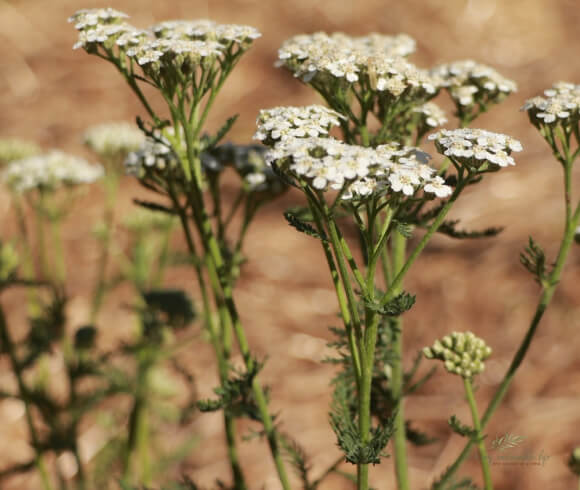
YARROW PREPARATIONS
As with most herbs we utilize, there are many options for preparations. Remember, yarrow is not recommended to take in large doses for any length of time. Here are a few preparations we have used….
YARROW TEA & YARROW INFUSION
Yarrow tea is often utilized for dry fevers and cold/flu symptoms. To do a quick infusion take 1-2 tsp of dried Yarrow, cover with 1 cup of boiling water and let steep for 10-15 minutes. For a more in-depth tutorial on making herbal infusions refer to “Herbal Infusions {How To Make & Use}”.
YARROW INFUSED OIL
Yarrow infused oil is wonderful to have on hand for strains, sprains, and injuries. Make balms/salves and ointments from this oil. To infuse the oil of your choice, take 1 part Yarrow to 7 parts oil. For a more in-depth tutorial refer to our “Calendula Oil” article.
YARROW TINCTURE
Tinctures may be our favorite way of harnessing the healing power of the herbs we grow on the hill. They last without spoilage for long-term, are efficacious, and easy to make.
To make a Yarrow tincture, fill a small cleaned jar with yarrow (leaves, flowers, small stems) which have been washed & dried, and cover with 80% or higher alcohol (we prefer vodka). Should there be alcohol sensitivites glycerin may be used. For a complete tutorial on making tinctures, refer to “How To Prepare For Cold & Flu With Elderberry Tincture”.
YARROW POWDER
Yarrow powder is wonderful to have on hand to use to treat inuries & stop the bleeding. To powder, simply dry the leaves (either air dry or using a dehydrator) and powder. We like to use our Vitamix for this process. Store powder in sealed container.
There is a myriad of ways to utilize these preparations. One of our favorite ways (how to’s coming soon) is to utilize Yarrow tincture in both our homemade hand santizer’s as well as our homemade bug spray repellant.
Do you already utilize Yarrow’s gifts? Join our conversation below and let us know your methods! Be sure to follow IMSL on all social media channels by simply clicking the icons found below.
Love, Light, & Laughter ~

DISCLAIMER
Recommendations and or suggestions made by this blog regarding husbandry and or herbal remedies etc. are not meant to replace solid advice from qualified professionals. None of the information on this blog has been evaluated by the FDA. Products or remedies mentioned are not intended to diagnose, treat, cure or prevent disease. Please do your due diligence. Research, talk to qualified professionals and proceed at your own risk.

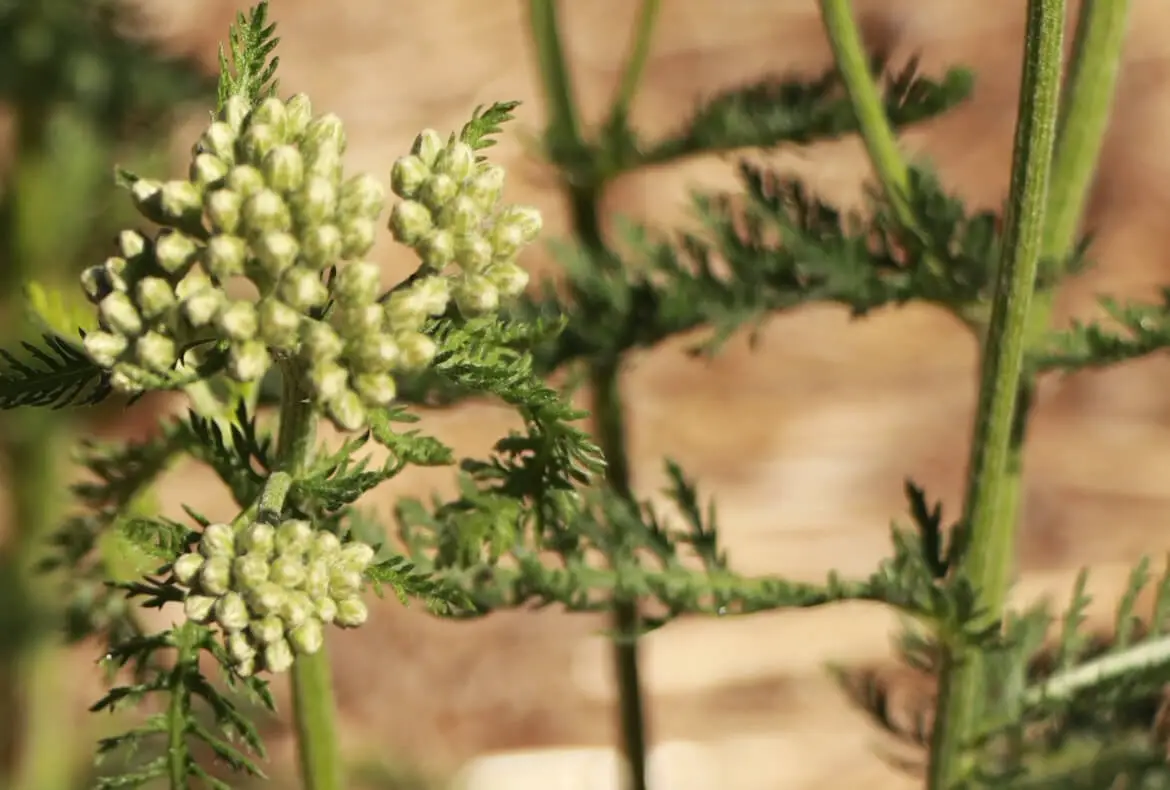
36 comments
Incredibly informative, Suzan! I have always admired the Native Americans’ knowledge of natural remedies. There’s so much we could learn from them. I also believe the potency of yarrow would be stronger based on where it grows. It makes sense!
So many benefits from yarrow! I need to add this to my herb garden.
I had no idea how many uses there were for yarrow!
As always, this is such an informative post! I’ve never heard of yarrow before. Fascinating!
Who knew that such a sweet little herb had so many uses. Thanks for sharing them.
I’ve heard of Yarrow but had no clue that it had so many uses, thanks for the information!
Great read. I just moved to a spot that has great light from a window. Any recommendations for a first-timer?
You can start your seeds indoors if the window has full sun, typically 6-8 weeks prior to your last frost date. I’ve never tried to grow continually indoors. It would be a fun experiment! Let me know how you do if you give it a try!
Wow, I never realized there were so many uses for it. I love learning all of this. Thanks for sharing.
So many of our medicines were derived from natural sources. It’s good to know that there are still alternatives. – Margy
Wow! I learned so much!
So much useful information in this one post. You really are amazing with the amount of detail you provide. When is the book coming out?
I’m amazed at how many names this yarrow has!! So many benefits too!
I’m always surprised by how many great benefits that these plants have. So many great uses for them.
Yay I learned something new today!
I had no idea yarrow could help heal episiotomy sites. It spreads pretty quickly where I live in neighbors’ gardens and it’s gorgeous. I have held off getting it because I wasn’t sure where to put it but reading all of this makes me want it more!
This was really interesting to learn about. It’s versatility is really cool and the history of it as well. It amazes me how plants and herbs can do so much to heal our bodies.
I love my yarrow essential oil. I’ll have to try and grow it in my garden!
I always learn so much from your blog! So interesting!
What a great little herb! I love learning about new ones. Thanks!
Thank you for all the information. I always learn so much reading your posts.
I had no idea about yarrow, its versatility and million aliases! Nice post!
Wow, I learned a lot. My son just had a bad bleeding wound and I put wound seal on it. Now I am interested to see if this was one of the ingredients. It was a powder.
What a great, educational article on yarrow. Sounds like I should include some in our gardening.
I had barely heard of yarrow before this post, so almost all of this info was new to me. I wouldn’t have associated yarrow with helping colds & flu. I believe God gave us plants for our healing and their versatility is astounding.
This is a great post! Most of this we did not know. Thank you for sharing.
I never really had any knowledge of the benefits of yarrow or even how to grow it! Thank you for sharing your experience of gardening and health benefits!
This was so informative, I hadn’t heard of yarrow but I had heard of a few of it’s other names. I didn’t really know what is was until now. Thank you for sharing I love natural remedies!
Thank you for all this helpful info! I’m growing yarrow myself for the first time ever this year, and it feels even more special to grow a plant steeped in history and lore!
Hopefully this will give you some ideas for use! Thanks so much for stopping by & reading.
I love learning new things! I have recently read that rinsing your hair with yarrow tea everyday can eliminate grey hair over time. Haven’t tried though! We are starting a new link party tomorrow. Embracing Home and Family at https://www.theeverydayfarmhouse.com I would love if you would link up with us!
Hello Jennifer!
I had not heard of the hair application for yarrow tea. Interesting! It’s such a versatile herb. I’ll be sure to check out your upcoming party!
Very informative post! Never heard of this herb before.
Amazing plants our creator has for us to use to help us heal and live a better life. Can I purchase seeds for this? I live in Florida.
Have a great week,
Kippi
Hi Kippi!
I agree, nature offers so much in the way of healing. Yes, you can purchase white yarrow seeds. I believe I initially purchased mine through FEDCO seeds. If you cannot find any, email me at [email protected] and I can harvest some for you 🙂
Be Well!
Suzan
Fascinating. And having been in healthcare, so many of our medicines have their roots (no bun intended) in herbs and nature. So your cautions are important. But this is an amazing and versatile herb. Impressive list of names alone – this is great to know. Thanks.